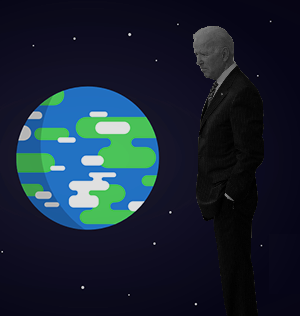2021 Earth Day: Biden’s Promises

Picture by Brandon Kim
May 14, 2021
Perhaps your Instagram feed surprised you on April 22 with a seemingly limitless number of posts about preserving Mother Earth. If so, you quickly caught on that it was the 51st anniversary of Earth Day, a national recognition of the issues facing the environment and a call to action. Past the images of nature’s beauties are significant moves that Americans should be conscious of moving forward.
Solving climate change is among the most pressing goals the United Nations has set for the world, but advances to accomplishing this monumental task were limited. Despite the 2015 Paris Climate Accord aimed at stabilizing the global temperature, 2016 and 2019 were the warmest and second warmest years on record, respectively. The 2010s was also the warmest decade on record. With every year that goals are not met, there is less time to solve climate change, so plans to curb the problem are more aggressive than ever.
In honor of Earth Day, Biden announced his climate plan. This was a highly anticipated reveal given that much of his campaign was dedicated to fighting climate change rather than ignoring it, something he accuses former President Trump of having been guilty of. According to Politico, Biden boldly plans to cut carbon emissions by 50 to 52 percent by 2030, bringing them down to levels comparable to those of 2005. Previously, plans of this sort aimed to accomplish such goals at later dates, namely 2050 and 2060. Still, the Biden administration has pushed for a tougher green agenda, and 83 nations updated their Paris Climate Agreements to aim for a 2030 goal. The statement was a victory for environmentalists, but for most Americans, the shift this new plan requires is intimidating. The Wall Street Journal writes that the U.S. would need to completely restructure its electric grid; tax incentives would help drivers purchase electric cars when there is no more gas to keep their old vehicles running; coal and even natural gas plants would have to fade into nothing, and solar and wind energy would need to increase production power by six or sevenfold.
While the move emphasizes the urgency of the situation, Chinese Foreign Ministry spokesperson Zhao Lijian held back on applause, noting that “The U.S. chose to come and go as it likes with regard to the Paris Agreement,” referencing the exiting and reentering of the agreement over the last year. These comments are just: the U.S. has a history of never following through on promises to heal the Earth. In 1997, President Clinton signed the Kyoto Protocol, the first international agreement to solve the climate crisis. Just weeks into the next presidency, Bush pulled back from the agreement. Again, during the Obama administration, the U.S. entered into the Paris Agreement, only to be taken out by the Trump administration and reinserted under Biden. The lack of consistency among presidents and political parties makes significant progress on the environment impossible. With Biden starting early on this issue, however, there may be some hope for real action.
Of course, change will rely on the willingness of Congress. Though Biden can enter into agreements with other nations to reduce carbon emissions and thereby allow the Environmental Protection Agency to set regulations, the President will still need the support of the legislative branch to enact policies that make these commitments binding to the American public.




